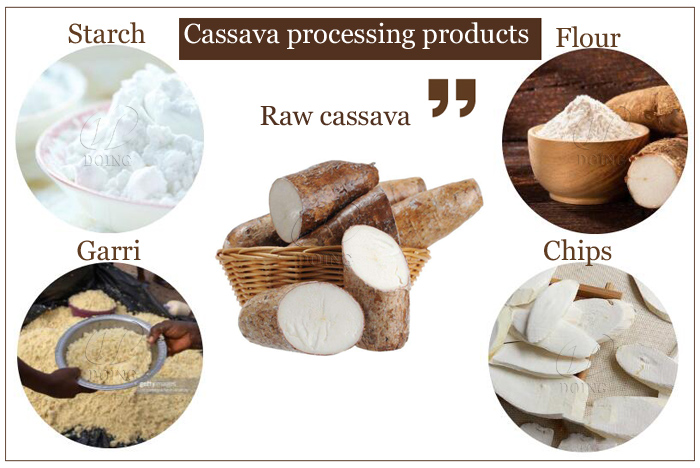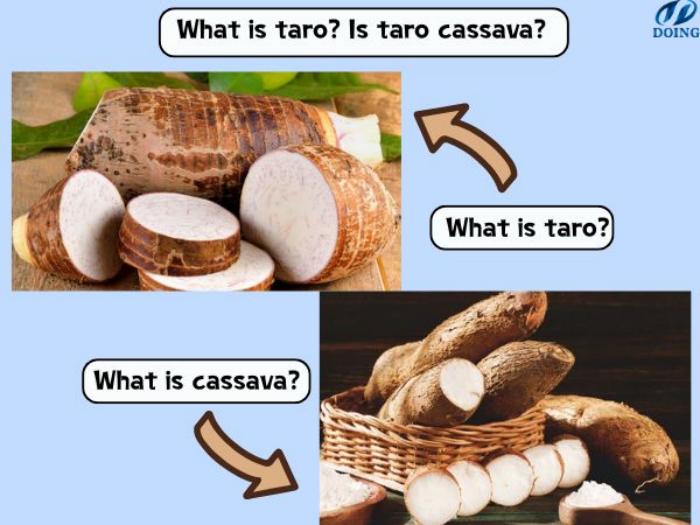What is taro? Is taro cassava?
Taro and cassava are often confused by people because of their similar appearance, so we often hear questions like "What is taro? Are taro and cassava the same?" in the field of food processing. Today, Henan Jinrui, as a professional cassava processing equipment manufacturer, will introduce taro and cassava to you in detail, and compare them in terms of appearance, use and other properties to help you understand the difference between taro and cassava!
 What is taro?
What is taro?
What is Taro?
Taro is a tropical root vegetable native to Southeast Asia. It is widely cultivated in various regions, including the Caribbean, Africa, and Hawaii. Taro is generally oval or spherical in shape, with a brown, hairy skin and a starchy, purple-speckled flesh with a nutty, sweet flavor.
Taro has a wide range of uses and can be eaten directly. It is usually used to make desserts and snacks, including taro paste (poi), bubble tea, ice cream and other food processing fields. In addition, taro is often used as a chemical raw material, medicine, cosmetics raw material and other industrial fields due to its high starch content (70%).
 What is cassava?
What is cassava?
What is Cassava?
Cassava, also known as yuca or manioc, is a root vegetable native to South America. Cassava is a perennial plant grown as an annual crop and is widely cultivated for its starchy root, especially in Nigeria. Cassava is long and narrow in shape, with a brown bark-like skin. Its roots have an earthy fragrance, a slightly sweet and nutty flavor, and a slightly bitter taste.
Cassava contains toxic substances such as cyanide, and needs to be properly processed before consumption, such as peeling, which can be done manually or using Henan Jinrui's peeling machine to achieve quickly peeling. The processed cassava is often used to process into garri, cassava flour, cassava chips and cassava starch.
 Difference between taro and cassava
Difference between taro and cassava
Differences Between Taro and Cassava
Both taro and cassava are starchy root vegetables, but there are still some obvious differences in their appearance, taste, nutritional content, uses, etc. The following is a comparison of the key differences between taro and cassava:
- Appearance: Taro is short and oval-shaped with a hairy exterior, while cassava is long and narrow with a bark-like skin.
- Flavor: Taro has a mild, nutty flavor with a slightly sweet aftertaste, whereas cassava has an earthy, slightly sweet flavor with a hint of bitterness.
- Nutritional Content: Taro is rich in nutrients such as dietary fiber, vitamins and light substances, while cassava contains a lot of starch and is an important source of carbohydrates.
- Culinary Uses: Taro is often used in dishes like poi, soups, and stews, while cassava is commonly used to make garri, flour, chips, and other processed foods.
- Toxicity: Taro is generally non-toxic and can be eaten after normal cooking, while cassava contains toxic cyanide and needs to be processed (such as peeling, soaking, frying and drying) before eating. Henan Jinrui is committed to the research of cassava processing machinery and can provide customers with equipment in this field.
Overall, taro is not cassava, taro and cassava are two different plants. Understanding these differences can help you choose the right ingredient for your recipes and dietary needs. If you want to know more about cassava or you want to start your business of cassava.Our sales representatives will recommend the most suitable products for customers based on their needs, and we can also customize them according to their requirements. If you are ready. Henan Jinrui is your best choice. Feel free to contact us!
Leave a message about What is taro? Is taro cassava?
- Do you want to buy machine?
- Yes, I want to buy machine
- No, I want to learn more in advance.
- What is your raw material?
- Cassava
- Potato
- Sweet potato
- Others
- 2. What is the final product you want to produce?
- Garri
- Cassava flour
- Cassava starch
- Cassava chips
- Attiekie
- Bammy
- Others
- 3.What is your capacity plan?
- Small scale garri machine
- 1ton per day
- 2tons per day
- 3tons per day
- 10tons per day
- 20tons per day
- Others
- 3.What is your capacity plan?
- Small scale
- 5tons per day
- 10tons per day
- 20tons per day
- 50tons per day
- 100tons per day
- Others
- 3.What is your capacity plan?
- Small scale
- 5tons per day
- 10tons per day
- 20tons per day
- 50tons per day
- 100tons per day
- 200tons per day
- 300tons per day
- Others
- 3.What is your capacity plan?
- Small scale
- Middle type
- Large scale
- What is your capacity plan?
- Small scale
- 5tons per day
- 10tons per day
- 20tons per day
- 50tons per day
- 100tons per day
- 200tons per day
- 300tons per day
- Others



